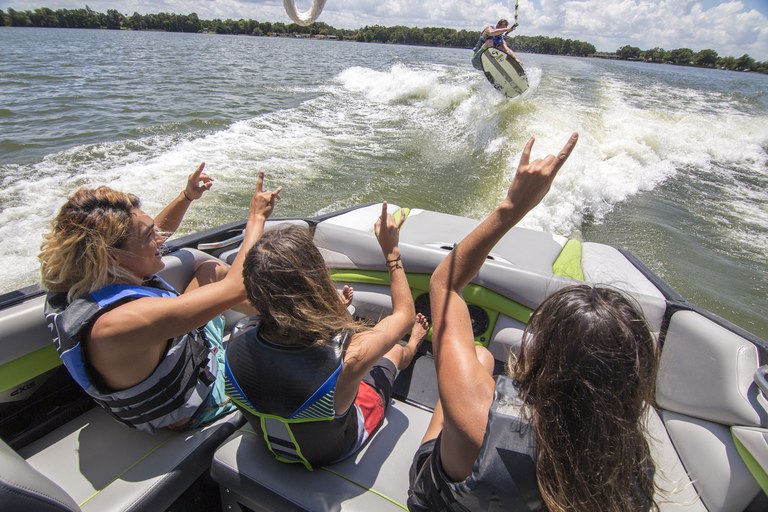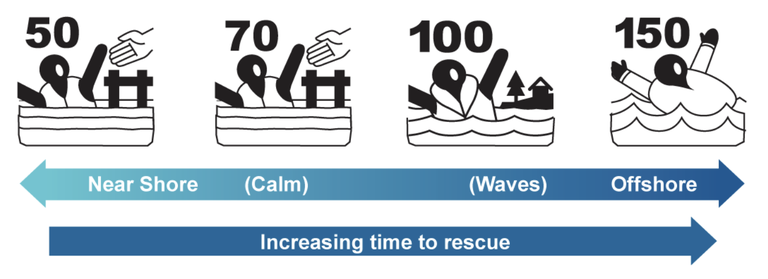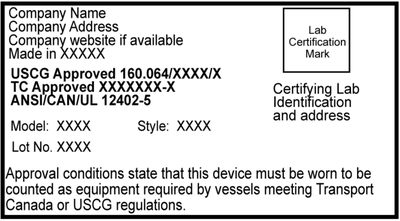Life Jackets

Accidents on the water happen fast. U.S. Coast Guard statistics show that drowning was the reported cause of death in 76% of recreational boating fatalities in 2024, and that 87% of those who drowned were not wearing a life jacket. That’s why boating safety advocates continue to push for increased and consistent life jacket wear on the water. Worry less when you Wear It!
How to Choose the Right Life Jacket
Today’s life jackets come in a variety of shapes, sizes, colors, and materials. No matter which life jacket you choose, be sure it’s right for YOU, your planned activities, and the water conditions you expect to encounter.
Try It On
- Check the manufacturer’s ratings for your size and weight to get started.
- Make sure the life jacket is properly zipped or buckled.
- Raise your arms straight up over your head while wearing your life jacket and grab the shoulder material, gently pulling up.
- If there is excess room above the openings and the life jacket rides up over your chin or face, it does NOT fit properly. A snug fit in these areas signals a properly fitting life jacket.
Fit Facts
- It is extremely important that you choose a properly fitting life jacket.
- Life jackets that are too big will cause the flotation device to push up around your face, which could be dangerous.
- Life jackets that are too small will not be able to keep your body afloat.
Important Reminders
- Make sure your life jacket is U.S. Coast Guard-approved.
- Double-check that your life jacket is appropriate for your favorite boating activities.
- Life jackets meant for adults do not work for children. If you are boating with children, make sure they are wearing properly fitted, child-sized life jackets. Do not buy a life jacket for your child to “grow into.”
Texas Life Jacket Laws
- It's Texas state law on recreational vessels under 26ft. in length when underway (including drifting or not at anchor), all children under 13 years old must wear a U.S. Coast Guard-approved life jacket. Adults must have a properly fitting life jacket that is easily accessible.
- For more regulations on life jacket requirements by vessel type, see Required Safety Equipment in the Outdoor Annual. Complete water safety information is available in TPWD's Water Safety Act, downloadable as a PDF file.
Inflatable PFDs
Inflatable life jackets are a popular choice for many adult boaters because they are lightweight, cooler in hot Texas weather, and offer freedom of movement. Inflatable life jackets are U.S. Coast Guard–approved devices that use CO₂ inflation systems. Because approval varies by model, boaters must follow the exact instructions printed on the life jacket’s approval label. When properly worn and maintained, they provide excellent buoyancy and are approved by the U.S. Coast Guard.
Because they require active maintenance and correct use, inflatable life jackets are not approved for:
- Anyone under 16 years old
- Personal watercraft operators
- Tow-sport participants (tubing, skiing, wakeboarding, etc.)
- Situations where impact or immersion is likely (whitewater, swift currents)
Inflatables are intended only for responsible adult boaters in calm, warm-weather conditions. They are not recommended for non-swimmers.
How an Inflatable Life Jacket Works
An inflatable life jacket provides buoyancy in one of two ways:
- Manual Inflation: The wearer pulls the handle to activate a CO₂ cylinder that inflates the chamber.
- Automatic Inflation: The jacket inflates when the water-soluble trigger dissolves after immersion, or by manual pull.
Most inflatables also offer oral inflation tubes as a backup.
Maintenance Is Critical
Inflatables require routine inspection to remain safe and effective. Boaters should:
- Check the CO₂ cylinder for rust, corrosion, or puncture.
- Ensure the green status indicator is visible and properly aligned.
- Inspect the inflation mechanism and dissolvable bobbin (if automatic).
- Test-inflate the chamber annually using oral inflation to check for leaks.
- Keep a spare CO₂ cylinder + bobbin in the boat or glove box.
If any part looks damaged, expired, or questionable—do not use it.
Advantages of Inflatable Life Jackets
- Lightweight and comfortable in hot weather
- Allows full range of motion while fishing, paddling, or operating the boat
- High visibility when inflated
- More likely to be worn, which increases survival chances
Comfort leads to compliance—and compliance saves lives.
Limitations to Consider
- Not suitable for high-impact or high-immersion activities
- Requires routine upkeep and replacement parts
- May not inflate if the mechanism fails, is obstructed, or the cylinder is spent
- Not ideal for cold-weather boating or rough conditions
If conditions are uncertain, always choose an inherently buoyant foam life jacket.
When to Choose an Inherently Buoyant Foam PFD Instead
Select a traditional inherently buoyant life jacket when:
- Water conditions are rough
- There is a high chance of entering the water unexpectedly
- You are operating at high speeds
- You are participating in tow sports
- You are a passenger under 16
Foam jackets provide immediate flotation and require no activation.
Understanding New Life Jacket Labels
Newer life jacket labels provide information about performance level, turn ability and warnings. These icons replace the traditional "Types" categories. Labels also display U.S. Coast Guard approval as well as approved use in the U.S. and Canada.
Performance Level
Performance level is measured numerically in Newtons buoyancy.
- Lower level number offers more mobility, comfort and style with good flotation, and intended for near shore (calm water) activities.
- Higher level number offers greater flotation, turning and stability in the water, and for offshore activities (greater time to rescue).
- There are areas where you may be boating near shore when rescue is hours away, and a higher level is needed.
- Be honest about your swimming ability. Poor swimmers may need a higher level to stay upright and easily tred water.

Turn Ability
Icons denote the ability of a life jacket to turn unconscious wearers face up.
 Life jacket will turn most unconscious wearers face up. Test before use.
Life jacket will turn most unconscious wearers face up. Test before use. Life jacket will not turn an unconscious wearer face up.
Life jacket will not turn an unconscious wearer face up.
Warnings
Icons denote life jackets that are not approved for the following activities:
 Water skiing
Water skiing Tubing or towed sports
Tubing or towed sports Personal watercraft (PWC) or wakeboarding
Personal watercraft (PWC) or wakeboarding White water paddling
White water paddling
New Icons Replace "Types"
The traditional "Types" categories are going away.
- New labeling system relies more on icons and less on wording.
- Older jackets and flotation aids labeled by “type” still meet regulatory requirements until no longer serviceable.
- Wearable life jackets will be divided into five buoyancy categories: 50, 70, 100, 150, and 275 Newtons (metric to
harmonize with Canadian standards. Choose the level of buoyancy for the type of activity. - The curved arrow indicates that it is likely to turn an unconscious wearer face up in the water.
| Old "Type" Life Jacket | New Icon |
|---|---|
| Type I | |
| Type II | |
| Type III | |
| Type IV | Called a "throwable" |
| Type V (special purpose vest that meets either I, II, or III standards) | Check the icons |
U.S. Coast Guard Approval / Approval for Use in the U.S. and Canada
Life jackets approved for use by the United State Coast Guard will display labels with the marks shown below. These labels also include approval for use of the life jacket in the U.S. and Canada.
